内容简介
作者简介
目录
A New Course of the English Literary History is a diachronic study of the literature of the United Kingdom of Great Britain and Northern Island,covering its whole range from the Anglo-Saxon Period all the way down to the Postwar Period.It aims to offer a basic framework of the English literary history.The general layout of the book follows the different literary periods chronologically,with every part typically discussing a new period.Accordingly,the whole book consists of nine parts,which are subdivided into 36 chapters.Each part gives a brief account of the historical background against which the literary works emerged,the major literary trend(s) and current(s) of thought that dominated the literary scene in the given period,and the representative literary figures and their literary achievements that attract the critical attention.The book begins with the Old English Literature or the Anglo-Saxon Period,which stretched out to six centuries from the mid-5th century to the mid-11th century marked by the Norman Conquest in 1066.Part One,composed of two chapters,focuses on Beowulf,England's national epic and the oldest surviving epic in the English language.The second part deals with the Medieval Literature,which covers the years from the mid-11th to the 15th century.The three chapters in this part discuss the Anglo-Norman period,the Age of Chaucer and the 15th century respectively,into which the Medieval Period is further divided.The romance,represented by Sir Gawain and the Green Knight,was the prevailing form of the Anglo-Norman literature.The Age of Chaucer roughly refers to the second half of the 14th century,when Geoffrey Chaucer lived and produced The Canterbury Tales,the peak of the medieval English literature.The 15th century witnessed the popularity of popular ballads,the most important of the English popular literature.The only important writer was Thomas Malory,whose Mort d'Arthur,based on Arthurian mythology,is the first major work of English prose.Part Three gives a sketch of the English literature during the Renaissance Period,which,according to some critics,lasted about one and a half centuries from 1476 or 1485 till 1625,and whose culmination came between 1578 and 1603.William Shakespeare was the most important literary figure in this period.He was so influential that the period is also called the “Age of Shakespeare.” Along with Shakespeare,there emerged not only a host of playwrights,including the other giant figures like Christopher Marlowe and Ben Jonson,but also some outstanding poets like Philip Sidney,Edmund Spenser,and others.Meanwhile,Thomas More,John Lyly and Francis Bacon made great contributions to the prose-writing.Hence this part is composed of four chapters.After a general introduction to the English Renaissance in the first chapter,the following three chapters handle drama,poetry and prose separately.Part Four,consisting of three chapters,is devoted to the Period of Revolution and Restoration (roughly the 17th century),which naturally falls into two phases—the Revolution and the Restoration—with the year 1660 as a dividing point.The 17th century is also called the age of “Four Johns” in the English literary history,as the notable writers of the century include John Donne,John Milton,John Bunyan and John Dryden.The “Four Johns” are therefore the primary interests here,among whom Donne and Milton are categorized under the heading of the Revolutionary Period,and Bunyan and Dryden under the Restoration Period.The years before 1660 is usually called the “Age of Milton” as Milton was the greatest writer of the years or even in the whole 17th century,while the years after 1660 is sometimes called the “Age of Dryden” as Dryden was the greatest poet between Milton and Pope and the most notable representative of English Classicism in the Restoration Period.The Age of Enlightenment,which roughly covers the 18th century,witnessed the emergence of several literary trends in English literature like Neoclassicism represented by Alexander Pope and Pre-Romanticism represented by William Blake and Robert Burns in poetry,and realism represented by Daniel Defoe,Jonathan Swift and Henry Fielding and Sentimentalism represented by Samuel Richardson and Oliver Goldsmith in prose writing.Moreover,in the second half of the 18th century there appeared two great playwrights,Oliver Goldsmith and Richard Brinsley Sheridan,who brought English drama to life.Accordingly,the fifth part,dealing with the 18th-century English literature,is made up of six chapters,centering on the reign of Classicism,the emergence of Sentimentalism and Pre-romanticism,the spread of realism as well as the rise of modern novel.Part Six is about the Age of Romanticism,which began with the publication of Lyrical Ballads in 1798 and ended with the death of Walter Scott in 1832.This age was emphatically an age of poetry.The glory of the age is seen in the poetry of William Wordsworth,Samuel Taylor Coleridge,Robert Southey,Lord Byron,John Keats and Percy Bysshe Shelley.The first three are usually accepted as the first generation of Romanticists or the Passive Romantic poets,the second three as the second generation of Romanticists or the Revolutionary Romantic poets.In essays there appeared Charles Lamb and William Hazlitt;and in fiction Walter Scott and Jane Austen are two important figures.The Romantic period is arranged in four chapters according to the literary achievements in such different genres as poetry,fiction and essay-writing.After Romanticism there came the Age of Realism in the English literary history,which is also called the Victorian Age,covering the years between 1832 and 1902 or between 1837 and 1901.The major contribution made by the English Critical Realists was their perfection of the novel.Hence much space of the seventh part is devoted to the prominent novelists like Charles Dickens,William Makepeace Thackeray,the Bronte sisters,George Eliot and Thomas Hardy as well.Additionally,one chapter is opened to handle the great poets like Alfred Tennyson,Robert Browning and Matthew Arnold,one chapter to discuss the essay-writing with Thomas Carlyle as the focus,and another chapter is offered to the literary trends at the end of the 19th century,including the Naturalistic trend,New Romanticism,and Aestheticism and Decadence.The English literature in the 20th century contains two periods—the early 20th century and the postwar period—with the Second World War as a dividing point.Part Eight outlines the early 20th-century literature in six chapters,which,except for drama that is exclusively introduced in one chapter,is chronologically grouped into the 1900s’ (i.e.,the Edwardians),the 1910s’ (i.e.,the Georgians and the war poets),the 1920s’ and the 1930s’.In drama,the early 20th century produced two important realist writers—William Butler Yeats and Bernard Shaw.The former dealt realistically with the daily life of the Irish country people in his plays,while the latter's plays like Mrs.Warren's Profession and Widower's Houses explore a range of social themes,including middle-class British society,militarism,education,and the situation of women.The greatest poets in this period are William Butler Yeats,who is better known as a poet than as a dramatist,and T.S.Eliot,who was also a great critic and a fine playwright.T.S.Eliot was the chief leader among writers during the first half of the 20th century.His The Waste Land expressed the temper of his age,the spiritual disease of the 20th century.He is accepted as the experimentalist of Modernist poetry in English language.Novelists of the early 20th century can be roughly divided into two groups,the realists (i.e.,the Edwardians represented by Arnold Bennett,H.G.Wells and John Galsworthy) and the Modernists.The most remarkable one among the first group should be John Galsworthy,who has been noted for portraying the history of English bourgeois life in his famous trilogies,especially in his first trilogy The Forsyte Saga .The representative writers of the second group mainly include D.H.Lawrence,James Joyce and Virginia Woolf.What they shared in their novels was that all of them turned their interest to describe what is happening in the minds of their characters.They insisted that fiction should explore the depths and recesses of personality,revealing an unending stream of impression,feelings and thoughts.In this sense,Lawrence was somewhat exceptional.He looked inward,not to show us a stream of impressions as Virginia Woolf did,but to explore those mysterious areas of feeling.Among these outstanding writers of the period four were awarded the Nobel Prize for literature.They are Rudyard Kipling,William Butler Yeats,George Bernard Shaw and John Galsworthy.The Postwar Period produced even more Nobel Prize winners for literature—T.S.Eliot,Bertrand Russell,Winston Churchill,Samuel Beckett,Elias Canetti,William Golding,Seamus Heaney,V.S.Naipaul,Harold Pinter and Doris Lessing.Centering on these Nobel Prize winners and other great literary figures,Part Nine,the last part of the book,sketches the English literature in the postwar context,which is sorted out in three chapters according to the literary genres like drama,poetry and fiction.The postwar poetic scene was a colorful one.On the one hand,such poets of the previous decades as Robert Graves,William Empson and Dylan Thomas were still highly visible.On the other hand,a new generation was emerging.While the Movement poets like Philip Larkin and Donald Davie became popular and attractive in the 1950s,in the following decades there appeared the outstanding contemporary poets like Ted Hughes,whose harsh,post-apocalyptic poetry celebrated simple survival,and Seamus Heaney,an Irish poet who was hailed for his exquisite style.In actuality different groups existed and tried to exhibit their own identities on the postwar poetic stage.In fiction the young writers of the 1950s created characters that represented their radical,parochial attitudes and became known as the “Angry Young Men.” These include Kingsley Amis’ Jim Dixon in his Lucky Jim,William Cooper's Joe Lunn in his Scenes from Provincial Life,John Gerald Braine's Joe Lampton in his Room at the Top,Alan Sillitoe's Arthur Seaton in his novel Saturday Night and Sunday Morning,and others.The glory of the postwar fiction is also seen in works by Lawrence Durrell,William Golding,Doris Lessing,Iris Murdoch and Muriel Spark.In addition,those writers like Anthony Powell,C.P.Snow and Joyce Cary became really established in the postwar years,although they made their presence already felt in the 1930s.The 1950s and the first part of the 1960s was the period in which the drama of the absurd prospered as a fashion.Samuel Beckett,a monumental figure,was instrumental in revitalizing the fine dramatic traditions by bringing in an existentialist and absurdist element,and ushering in the era of the drama of the absurd in recent literary history.His most famous play Waiting for Godot is thematically concerned with man's salvation through God's grace.Then there were John Osborne,whose play Look Back in Angergave manifest expression to the disaffection of the postwar generation,and Harold Pinter and Tom Stoppard,who were to pick up where the older dramatists left off and make headway in their unique fashion.* * *The book is based on my years of teaching and research experience in English literature.To some extent,it is an expansion of my reading and lecture notes and a kind of sorting of the related materials in the literature.It is thus applicable to undergraduates,graduates and all those who tend to get acquainted with the literature,and is intended to serve both as a textbook and a reference book.The book distinguishes itself from the common kindred textbooks for this course.First,it is characterized by wide coverage.To satisfy its readers with a wide range of options,the book tries to contain the influential writers and their representative works as comprehensively as possible.Then,centering on the literary survey,each part of the book is complete with related exercises,objective and subjective,so that readers will get impressed.Another highlight of the book is the “Glossary” appended to the survey (the main body of the book).It picks out all the terms mentioned in the book,which might be unfamiliar to some readers,and explains and/or defines each of them.This benefits not simply learners of English literature but also learners of other Western literatures,especially those of American literature.Lastly,the five appendices at the end also add value to the book.They not just list the Nobel Laureates in literature,the Poets Laureate of the UK,the recipients of the Golden PEN Award in English literature,and the winners of the Booker Prize for fiction,but provides some basic information about the different periods in English history as well.All these facilitate those who take interest in English literature.* * *A New Course of the English Literary History is my collaborative work with Professor Wang Mouqing and Miss Kang Weihua.In practice,around half of the book is attributed to the two co-authors,that is,250,000 words to Wang Mouqing (王谋清) and 140,000 words to Kang Weihua (康维华).My (Shui Caiqin's[水彩琴]) contribution to the book is the other half,which totals up to 361,000 words.Shui Caiqin
全部显示∨
Preface
Part One The Anglo-Saxon PeriodChapter 1 The Early Invasions of the British Isles
Chapter 2 Anglo-Saxon Literature2.1 Poetry
2.2 Prose
Part Two The Medieval AgeChapter 3 Anglo-Norman Literature3.1 Norman Conquest
3.2 Literature
Chapter 4 Literature in the Age of Chaucer4.1 William Langland
4.2 Geoffrey Chaucer
Chapter 5 Literature in the 15th Century5.1 Popular Ballads
5.2 Sir Thomas Malory
Part Three The Renaissance PeriodChapter 6 English Renaissance6.1 Background
6.2 Renaissance
Chapter 7 Poetry in the Renaissance Period7.1 Sir Thomas Wyatt
7.2 Henry Howard,Earl of Surrey
7.3 Sir Philip Sidney
7.4 Edmund Spenser
Chapter 8 Prose in the Renaissance Period8.1 Sir Thomas More
8.2 John Lyly
8.3 Thomas Nashe
8.4 Francis Bacon
Chapter 9 Drama in the Renaissance Period9.1 English Drama
9.2 Thomas Kyd
9.3 Christopher Marlowe
9.4 William Shakespeare
9.5 Ben Jonson
Part Four The Period of Revolution and RestorationChapter 10 Historical Context
Chapter 11 Literature in the Period of Revolution11.1 Literary Characteristics
11.2 Metaphysical Poets
11.3 Cavalier Poets
11.4 John Milton
Chapter 12 Literature in the Period of Restoration12.1 Literary Characteristics
12.2 John Bunyan
12.3 John Dryden
12.4 The Restoration Theater
Part Five The Age of EnlightenmentChapter 13 Introduction13.1 Background
13.2 Enlightenment
13.3 Literature
Chapter 14 Neoclassical School14.1 Alexander Pope
14.2 Joseph Addison (1672-1719) and Sir Richard Steele (1672-1729)
14.3 Samuel Johnson
14.4 James Boswell
Chapter 15 Fiction of Realistic Tradition15.1 Daniel Defoe
15.2 Jonathan Swift
15.3 Henry Fielding
15.4 Tobias George Smollett
Chapter 16 Sentimentalist Novels16.1 Samuel Richardson
16.2 Laurence Sterne
16.3 Oliver Goldsmith
Chapter 17 Poetry of Pre-Romanticism and Sentimentalism17.1 Pre-Romanticism
17.2 Sentimentalism
17.3 Representative Poets
Chapter 18 Drama in the 18th Century
Part Six The Romantic PeriodChapter 19 English Romanticism19.1 Background
19.2 Romanticism
19.3 Literature
Chapter 20 Romantic Poetry20.1 Representative Poets of the First Generation
20.2 Representative Poets of the Second Generation
Chapter 21 Fiction in the Romantic Age21.1 Sir Walter Scott
21.2 Jane Austen
Chapter 22 Essays in the Romantic Age22.1 Charles Lamb
22.2 William Hazlitt
22.3 James Henry Leigh Hunt
22.4 Thomas Penson De Quincey
Part Seven The Period of RealismChapter 23 Critical Realism23.1 Background
23.2 Realism
23.3 Literary Currents
Chapter 24 Critical Realist Novels24.1 Charles Dickens
24.2 William Makepeace Thackeray
24.3 George Eliot
24.4 The Bronte Sisters
24.5 Elizabeth Gaskell
24.6 George Meredith
24.7 Samuel Butler
24.8 Thomas Hardy
Chapter 25 Victorian Poetry25.1 Alfred,Lord Tennyson (1809-1892)
25.2 The Brownings
25.3 Matthew Arnold
Chapter 26 Victorian Essays26.1 Thomas Carlyle
26.2 John Stuart Mill
26.3 John Ruskin
Chapter 27 Literary Trends at the End of the 19th Century27.1 Naturalistic Trend
27.2 New Romanticism
27.3 Aestheticism and Decadence
Part Eight The Early Twentieth CenturyChapter 28 Introduction28.1 Background
28.2 Literature
Chapter 29 Drama in the Early 20th Century
Chapter 30 The Edwardians30.1 Arnold Bennett
30.2 Rudyard Kipling
30.3 John Galsworthy
30.4 H.G.Wells
30.5 Joseph Conrad
30.6 E.M.Forster
30.7 Katherine Mansfield
Chapter 31 The Georgians and the War Poets31.1 W.H.Davies
31.2 Walter de la Mare
31.3 Philip Edward Thomas
31.4 John Drinkwater
31.5 Rupert Brooke
31.6 Wilfred Owen
31.7 David Jones
31.8 Robert von Ranke Graves
31.9 Edmund Blunden
Chapter 32 The 1920s’ Literature32.1 Novel
32.2 Poetry
Chapter 33 The 1930s’ Literature33.1 Poetry
33.2 Fiction
Part Nine The Postwar PeriodChapter 34 Postwar Poetry34.1 The Movement Poetry
34.2 Poetry since the 1960s and 1970s
34.3 Younger Poets of the Later Period
Chapter 35 Postwar Fiction35.1 “Angry Young Men”
35.2 Other Writers on the Postwar Literary Scene
Chapter 36 Postwar Drama36.1 Samuel Barclay Beckett
36.2 Harold Pinter
36.3 Sir Tom Stoppard
36.4 John James Osborne
36.5 Sir Arnold Wesker
Glossary
Key to Exercises
Appendix Ⅰ List of Nobel Laureates in Literature
Appendix Ⅱ List of Poets Laureate of the UK
Appendix Ⅲ List of Recipients of the Golden PEN Award in English Literature
Appendix Ⅳ List of Winners of the Booker Prize for Fiction
Appendix Ⅴ Periods in British History
References





